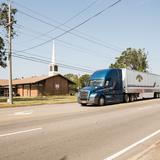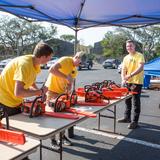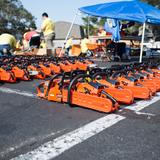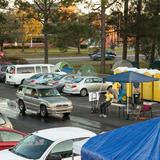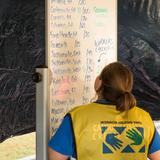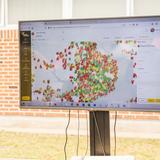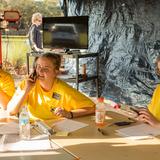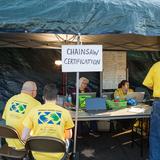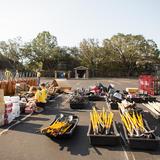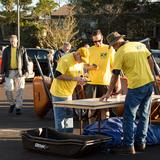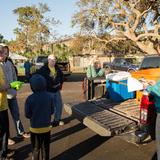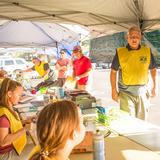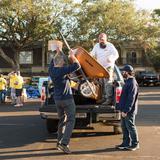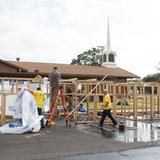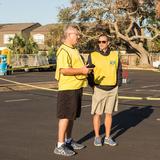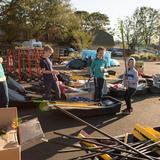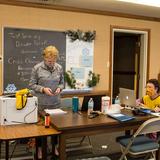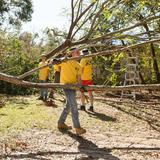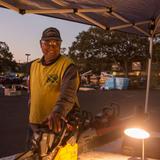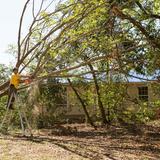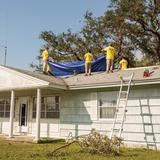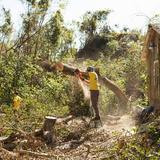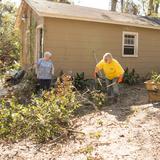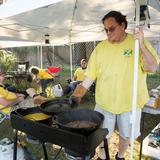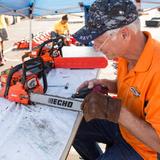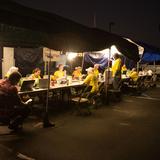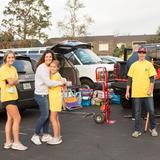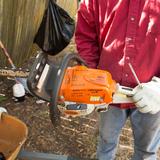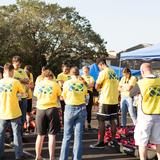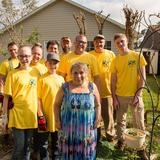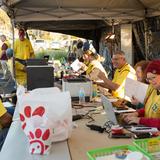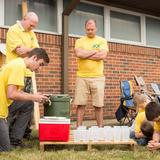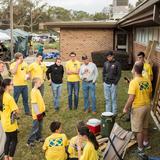In a period of six weeks, three hurricanes struck the U.S. Gulf Coast from Southeast Texas to the Florida Panhandle. Wherever disasters occur, The Church of Jesus Christ of Latter-day Saints organizes before and after to provide a helping hand.
Downloadable B-roll / SOTs| Temple Square is always beautiful in the springtime. Gardeners work to prepare the ground for General Conference. 2012 Intellectual Reserve, Inc. All rights reserved. | 1 / 38 |
The Church is often among the first organizations to respond to disasters. “We’ve learned [disaster preparedness over the years] as a Church … we do really well [in assisting] when we have a quick response,” said Michael Lavoie, an area welfare specialist covering the Southeast United States.
For the past four weekends, Lavoie has overseen the command center operations in Pensacola, Florida, following Hurricane Sally, a Category 2 storm, which made landfall along the Alabama coast in mid-September. The hurricane brought 100-mile-per-hour winds and millions of dollars in damage to homes and property in the region.
More than 1,900 Latter-day Saint Helping Hands volunteers wearing yellow shirts from congregations in Alabama, Georgia, and northern and central Florida gathered on Friday through Sunday, October 16–18, 2020, in Pensacola and Daphne, Alabama, to help residents they have never met. The volunteers, including many families, cut down fallen trees, protected damaged roofs with tarps, and prayed together.
During the four weekends of service, more than 6,500 Latter-day Saints cleaned up nearly 4,000 homes damaged by Hurricane Sally. A total of 130,000 hours were donated by the volunteers.
Other significant community-wide Church volunteer efforts ensued after powerful Hurricane Laura, a Category 4 storm, crossed the southwest Louisiana coast with 150-mile-per-hour winds on August 29. A third hurricane, Delta, hit southwest Louisiana on October 12.
Helping Hands Volunteers Respond to Service Needs
Assistance by Helping Hands volunteers along the Gulf Coast and Southeast U.S. has become a way of life. Many who live along coastal areas have helped their neighbor’s numerous times, knowing that their fellow residents will be there to help them when a storm strikes their hometown.
Church volunteers whose homes were not directly impacted by these hurricanes traveled five or six hours to coastal areas to help their fellow southerners from cities such as Dallas, Little Rock and Atlanta.
One of the volunteers cutting down trees this weekend was 90-year-old Francisco Pizarro, who traveled 450 miles from his home in Orlando, Florida, to assist. Pizarro has helped with the cleanup efforts many times following hurricanes and tornadoes along the Gulf Coast. He described his 24-inch saw as “his companion.” With good humor, he said his wife tells him he should not work so hard. Pizarro said residents who learned of his age while he was cutting down trees “just think I’m crazy.” He serves as a temple worker in the Orlando Florida Temple.
Robert Kershaw of Jonesville, Georgia, drove five hours and brought his 13-year-old daughter Michelle to Florida to volunteer with him. “It’s been a great opportunity to come and serve and share the love of Jesus Christ. We’ve prayed with them, and it’s been a wonderful opportunity to share and serve others.”
Residents who received help from the storms expressed their gratitude for the work done.
About a dozen and a half large trees blew down on Scott Mandel’s property. He described the cleanup effort as a massive undertaking, but the job was made lighter thanks to the help of what he said was “a coalition of Jesus’s followers.”
Mandel said, “I’m Catholic and I have Mormons and Baptists helping me clean my yard, so nothing can be more fitting than Jesus Christ in His word. You know that God’s up there, and He’s helping us out, and I just thank the Lord for that.”
Polly Harrison said she was in in her bedroom when a tree fell during the hurricane. She said if the trusses had not held, she would have been crushed. “The Lord was watching over me, that’s for sure. And then your group [of Helping Hands volunteers] came and helped me today, which was such a blessing.”
Harrison continued, “[The volunteers] were all cheerful and loving and kind. We said a prayer at the beginning, and we said a prayer at the end. Absolutely a godsend.”
Retired nurse Evelyn Wilson lives in a mobile home where the hurricane toppled trees and pressed tree limbs against the downed power lines to her home. The volunteers cut down the branches sparing her the cost of having the trees removed. “This crew came here and took that [tree] down and is now keeping me from worrying about that. God sent [this] crew,” she said.
Lynn Dobry, a disaster recovery specialist at Be Ready Alliance Coordinating for Emergencies (BRACE), said she was grateful for the support from the Church. BRACE is a disaster organization that engages in emergency preparedness, response and recovery efforts.
“I can honestly say that I have tears in my eyes imagining all of the hearts that your team has touched in our community as a result of completely selfless servants who want to help in our time of great need,” said Dobry. “Words will never adequately express how grateful we are.”
Preparing for Disasters
Planning the Church’s readiness for the annual U.S. hurricane season begins months in advance.
“A group of various special area welfare specialists get together once a year,” said Lavoie, who explained that the Church’s preparedness process begins during the first quarter of each year.
“As we prepare for those disasters ahead of time, we become more organized,” he added. “We typically discuss plans on how we would operate command centers and process.”
In advance of the storms, the Church places relief supplies provided by Latter-day Saint Charities at larger bishops’ storehouses in geographically strategic locations around the country so when disaster strikes, the emergency efforts can be easily deployed. In the Southeast U.S., supplies are stored in Orlando, Florida; Slidell, Louisiana, near New Orleans; Tucker, Georgia, just north of Atlanta; and Raleigh, North Carolina.
“We’re able to respond fairly quickly to pretty much any disaster,” said Lavoie.
“Once we see something brewing … in the Atlantic or in the Gulf, we have area welfare specialists that monitor those [storms] and alert the Area Seventies that there may be a storm hitting landfall,” he said.
Trucks are then loaded with supplies and some even are sent to designated areas outside of the storm’s path in anticipation of the potential disaster.
“We will jump on a video call and discuss our plans in preparation based on the storm’s path. We’ll try to determine where command centers should be set up, and the stakes [group of congregations] that are affected,” said Lavoie.
“We’ve designated what we call a sister stake concept where perhaps a stake that is not in the path of the storm but nearby is ready to come in and run a command center.”
Command Center Operations
“The command center’s job is to prioritize those work orders to identify where to send all of these volunteers that are coming in from all over so that they can have a great experience when they come work, but also that we make the greatest impact in the community,” said Lavoie.
In severe disaster situations such as Hurricane Sally, a command center is set up the first weekend following the storm.
Tasks include cleaning up tree debris and mucking out flooded homes. Volunteers also place tarps on damaged roofs.
“We work with local leaders to determine which congregations can come in and provide workers to the area,” he said.
Once leaders determine how many workers are needed, the right amount of supplies are brought in for the available workers and number of work orders.
“It’s all integrated process. When you think about supplies, the workers, and the work that needs to be done in an area, we’re doing our best to match all of those three up,” said Lavoie.
“As a command center staff, we encourage a sister stake [a neighboring group of congregations who are being trained] to start showing up at least Friday by noon. We coordinate with the bishop storehouse for the truck to arrive, so that the supplies can be unloaded and staged properly,” he said.
Lavoie said Church leaders try to choose command center locations that have nearby camping for the volunteers. “In some cases, they may get hotels, but we want to have adequate camping near command center so the workers will feel comfortable in staying.”
Volunteers stay Friday and Saturday nights and work all day on Saturday and Sunday morning.
On this weekend in Pensacola, pleasant October temperatures and lower humidity made for ideal working conditions, but the work was still exhausting.
“I think we went to five [or] six different places and cutting up trees and moving them to the road,” said volunteer Jason Farnsworth, who stayed at a camp with a son and daughter.
Farnsworth said he was ready to go to bed before the sun went down after putting in a full day of work with a chainsaw, including helping a woman with some downed trees after she spotted them working at her neighbor’s home. “She told us, ‘I’ve been praying for help,’ and I was like, ‘Well then, that’s why we’re here,’ so just really just a spiritual, emotional day.”
“On Sunday morning when the workers wake up, because of COVID-19 restrictions, they’re able to gather together in their own team at their campsite and have the sacrament and listen to a spiritual message,” said Lavoie.
He continued, “They’re able to start the Sabbath day off right and be able to go out and work a few work orders, but it gives them that spiritual protection and really closes out the weekend, reminding them that it is the Sabbath day.”
Online Community Collaboration
“We have volunteers that are really spread out across the country, sitting at home with an internet connection and their phone, answering a volunteer hotline. “So that survivors after disaster, call a toll-free number, they're able to enter in the work order into the map into a system,” explained Lavoie.
Using a third-party tool developed by a Latter-day Saint several years ago, local leaders are able to coordinate volunteer efforts across multiple projects and through multiple charitable organizations.
The tool’s use begins with a phone call.
“Based on the type of work that they need, an icon will show up on the map,” he said. If they need a tree cut down, or they need some tree work, a tree will show up. If their house has been flooded, and they need all the furniture and everything removed, then a boot will show up.”
Those at the command center look at the map, look at the type of icon, determine what type of work is needed, and match that up with the type of work that the workers want to do or evaluate the crew classification.
“It's just an amazing efficient way to do volunteer work,” emphasized Lavoie.
Before work orders begin, the map icons are all red. Assignments taken by community organizations turn yellow, and completed work turns green.
With enthusiasm, Lavoie described the most rewarding aspect of his assignment at the command center. “I think my favorite part is seeing all those icons turned green. You want to see that sea of red go away. That means that we did something. You know that each one of those is an individual that got helped.”
The Value of Missionaries
The Church involves full-time missionaries in its cleanup efforts across the country.
“We’ve learned that the full-time missionaries [are] a great resource. They’re young, they’re energetic,” said Lavoie. “With it being COVID-19 this year, they’ve been quarantined in their apartment a little bit. This disaster has allowed them to come out and get into the community.”
The missionaries can scope out work orders and take pictures of the work sites. They also labor alongside the work crews in the field.
Service missionaries also help staff the command centers and provide training for the volunteers.
A Culture of Service
Latter-day Saints learn about the importance of service in their teachings about the gospel of Jesus Christ.
“When we think about the promises that we make [at baptism] to serve our fellow man, there’s no better way to come in after a disaster and really help those that aren’t even members of the Church and help our brothers and sisters that are suffering,” said Lavoie.
“You hear stories of people that have prayed for help, and they see an army of yellow shirts come in, and they call us angels. And it really makes it worthwhile, all the setup that we do and all the work that it takes to process a number of workers through a command center,” he said.
“We get asked … why yellow and why the helping hands? … The yellow symbolizes that there is hope,” shared Lavoie. “I think it’s amazing when you see 20 or 30 yellow shirts converge and clean up a yard that would take days for the homeowner to do themselves. We knock it out in an hour. And they’re smiles all the way around.”
Teenagers were among the thousands of volunteers helping in recent weeks. They are among the rising generation of Latter-day Saints who are a part of the unique culture of service by Church members.
Sixteen-year-old Emmanel Omoregbe of Lilburn, Georgia said, “We’re here because we love to serve, and we want to help the people that we can and do the best we can to show love and kindness to others like the Savior did. And we are striving to be more like Him.”
Esther Oldham, 15, lives in Bonaire, Georgia, which is more than a five-hour drive from Pensacola. Her parents and brother were vacationing at Disneyworld in central Florida. When they knew there was the opportunity to help, they ended their vacation and made the five-hour drive home. Once repacked, the Oldhams then drove all night to Pensacola so that they could begin working on Saturday morning.
Oldham said, “I just really like to help people, and I think it’s a really rewarding experience to be able to come out here and do this. I think it’s really good to help and give encouragement and say there is still hope.”
Lasting Feelings and Friendships
As volunteers complete their service and return home, they say they are fatigued physically but are as enthused emotionally as if they just arrived.
“It has been a great opportunity to come and serve today,” expressed Latter-day Saint volunteer Robert Kershaw. He traveled with his daughter to Pensacola from Fayetteville, Georgia, to help clear debris from yards and tarp roofs. “We’ll come out and just share the love of Jesus Christ and help people. … We’ve prayed with them, and it has been a wonderful opportunity to share and to serve others.”
“I’m tired, but I feel rewarded,” said Kershaw’s daughter, Michelle. “I’m here to help people, and this is what I should be doing.”
“The blessings are poured out in the hearts of those volunteers, and they feel uplifted, and they go home feeling like they’ve made an impact on the world,” said Lavoie.
“They go home feeling that they’ve sacrificed for another individual who they may never see again,” he concluded.
Everyone knows it is only a matter of time before the next storm threatens. When that happens The Church of Jesus Christ and its members will be ready for the storm and ready to help each other and their neighbors.


